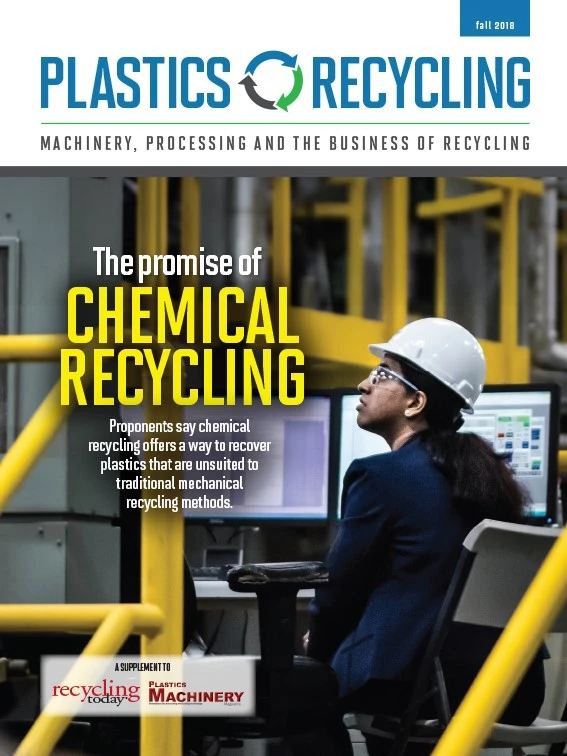_fmt.png)
A new granulator with more blades and a mechanism for force-feeding has given a New York bottle recycler an edge in its efforts to increase its capabilities.
The recycler, UltrePET LLC, Albany, New York, turns polyethylene terephthalate (PET) bottles sourced from curbside and bottle-deposit programs into Food and Drug Administration- approved, 100 percent postconsumer pellets and flakes. The company used to operate five granulators—three to process clear PET and two for green PET.
UltrePET concluded that it needed to get more throughput from its granulators. Specifically, the company wanted to increase its output of clear PET. UltrePET shifted a machine that was processing clear plastic over to handling green PET and replaced the grinder that was previously dedicated to processing green material with a new unit to process clear PET. Although it wanted a larger capacity granulator, the company could accommodate a granulator that was only slightly larger than the machine it was replacing.
UltrePET purchased a Herbold Meckesheim USA granulator, the SML 60/100-F7-3-SB. Because UltrePET’s “preference was to stay with the same model units [so] as to share spare parts to limit new parts inventory,” the new granulator mostly mirrors the machines UltrePET already had installed, says David Lefrancois, president of Herbold, North Smithfield, Rhode Island. However, unlike the older machines, which are gravity-fed, the new machine comes with a double-screw feed system that crams the cutting chamber with bottles.
“By adding the force-feed trough, Herbold was able to produce the same output rate of two machines in a single unit,” Lefrancois says.
The optional forced-feeding mechanism prevents bottles from bouncing above the rotor, which typically occurs with conventional granulators, he says. That increases the granulator’s cutting efficiency and output.
“What we decided to do instead of buying the same style grinder, we bought a grinder that was a little more robust and [had] a little more capacity and a force-fed grinder,” says Raymond Harris, UltrePET manufacturing process specialist.
Other benefits that come from using the force-fed granulator include reduced horsepower demand, footprint and noise. It saves energy overall. The machine also offers even rotor loads, resulting in fewer fines and less dust in the regrind, according to Herbold.
Lefrancois says granulators that feature the force-fed design employ either vertical or horizontal screws and a material surge bunker to keep bottles moving steadily.
The SML machines are general- purpose granulators. A centrally hinged, two-piece housing divided at an inclined angle provides easy access to the cutting chamber for maintenance. The rotor and bed knives are mounted at opposing angles for a steady cutting gap the length of the knife. That also lowers noise, the company says.
The 60/100 model’s feed space is 29.5 inches by 38.5 inches. The rotor diameter is 24 inches. Its rated capacity ranges from 1,540 to 3,520 pounds per hour.

The granulator’s smart controls respond to changes in motor amperage, machine vibrations and material volume to optimize the unit’s throughput.
Another feature of the machine is its vibration sensing, which lets maintenance operators know when it’s time to service the knives. “This allows for maximum output, reduction of fines, reduction in energy consumption and protects the machine from excessive damage,” Lefrancois says.
For blade changes, the machine uses hydraulics rather than a manual lift. The new Herbold granulator comes with a seven-arm rotor, instead of the four-arm versions that make up most of UltrePET’s fleet. Both versions have two blades on each arm, giving the new granulator a total of six additional blades.
UltrePET, which runs its recycling equipment 24 hours per day, changes blades on the new machine about every day and a half to two days. Harris adds that once the new machine was installed sometime between late 2016 and early 2017, UltrePET experienced a couple of minor issues, primarily involving the electrical setup, but Herbold quickly resolved them.
Since the new machine was installed, UltrePET has significantly increased the amount of PET it granulates. “This one has probably bumped our grinding up about 30 to 35 percent,” Harris says. “The more we do, the more that we can wash in our wash line, and the quicker we can diminish our inventory out here. Right now, we’re packed with material. We keep buying it so we don’t run low through the winter months.”
Overall, Harris says the company is happy with the investment. “[The grinder] almost grinds 2-to-1 over the other grinder. And it’s basically the same size.”
It’s spurred thoughts of expansion, as well. “If we could fit more of them in, we probably would buy more down the road,” he says. “Our grinding configuration doesn’t really [allow for much growth]. I think we could possibly put one more in. But I don’t think we could do two more.”
For more information:
Herbold Meckesheim USA, 401-597-5500, www.herboldusa.com
UltrePET LLC, 518-459-1080, www.ultrepet.com

Explore the November 2018 Plastics Recycling Issue
Check out more from this issue and find your next story to read.
Latest from Recycling Today
- BMW Group, Encory launch 'direct recycling’ of batteries
- Loom Carbon, RTI International partner to scale textile recycling technology
- Goodwill Industries of West Michigan, American Glass Mosaics partner to divert glass from landfill
- CARI forms federal advocacy partnership
- Monthly packaging papers shipments down in November
- STEEL Act aims to enhance trade enforcement to prevent dumping of steel in the US
- San Francisco schools introduce compostable lunch trays
- Aduro graduates from Shell GameChanger program





